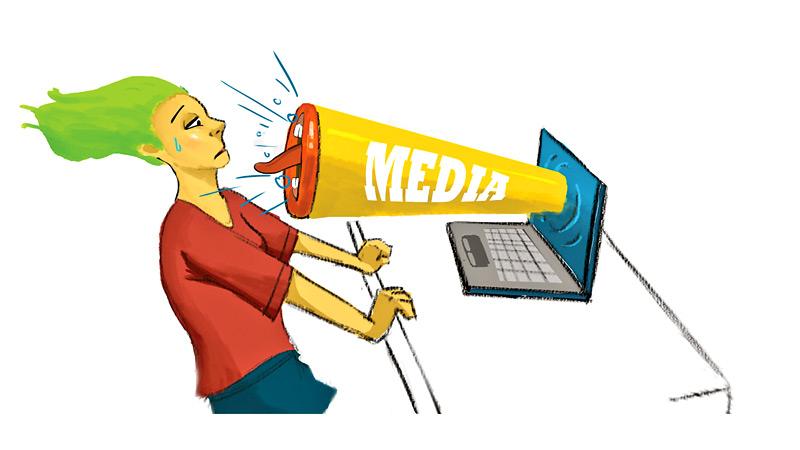
 The media scene in Sri Lanka is very vibrant at the moment, with a range of options for the citizens to choose from. Newspapers have been printed here since the 19th century and the newspaper you are reading now is itself closing in on its centenary. Radio in Sri Lanka too is nearing that mark. Even the ‘latest’ entrant to the media landscape in the country, television, has been in our living rooms since 1978. In fact, the Sri Lanka Rupavahini Corporation (SLRC) turned 41 this month.
The media scene in Sri Lanka is very vibrant at the moment, with a range of options for the citizens to choose from. Newspapers have been printed here since the 19th century and the newspaper you are reading now is itself closing in on its centenary. Radio in Sri Lanka too is nearing that mark. Even the ‘latest’ entrant to the media landscape in the country, television, has been in our living rooms since 1978. In fact, the Sri Lanka Rupavahini Corporation (SLRC) turned 41 this month.
 The media’s role is to inform, educate and entertain. While the electronic media offers a fleeting glimpse of news as it happens (“breaking news”), it is up to the newspapers to analyse the day’s events, almost 24 hours later, in-depth. Granted, there are television magazine programs such as Gravitas (WION TV) that do a fair news analysis, but TV cannot match the newspapers in this department.
The media’s role is to inform, educate and entertain. While the electronic media offers a fleeting glimpse of news as it happens (“breaking news”), it is up to the newspapers to analyse the day’s events, almost 24 hours later, in-depth. Granted, there are television magazine programs such as Gravitas (WION TV) that do a fair news analysis, but TV cannot match the newspapers in this department.
Nevertheless, there has been a subtle shift away from the purely informational role played by the media to focus more on ‘soft’ issues (lifestyle, gossip) to keep the viewers and readers in thrall. While this is not a bad trend in itself, it has also led to a situation where the news itself is sensationalised or embellished to attract the reader, listener or viewer. This is especially so with news about murders and suicides which are reported almost with unrestrained glee by some media outlets.
Intense competition
One reason for this trend is the intense competition among the media outlets. This is even more pronounced in the electronic media, where there is a discernible race to become the ‘first’ with breaking news. The truth is sometimes a casualty in this race. By the time the false narrative is corrected, if at all, the falsehoods have had a flying start. As they say, a lie goes halfway around the world before the truth gets a chance to put its pants on. No attempts are usually made to verify the claims contained in these initial news snippets and the viewer gets a wrong impression, which he or she thinks is the correct one. In any case, with viewers and listeners getting bombarded with news 24/7 through a variety of media, it is difficult for anyone to guess the truth.
As it is, the media landscape is littered with hundreds of conventional options but there is another new player in town. The Internet and its sibling (or is it offspring?) the social media. All the traditional media houses, including the publisher of this newspaper, maintain a presence on the Web and also social media accounts. Most young people do not read the traditional printed newspapers any more. But they do read the newspapers on the Web, on their tablet or smartphone.
 While one might be inclined to describe this as a good trend, the time spent on newspapers is likely to be a fraction of their screen time. The rest is most likely to be devoted to social media, especially the likes of Facebook, Instagram, WhatsApp, TikTok, Viber, YouTube and Twitter. And they usually get their news “fix” from these sites.
While one might be inclined to describe this as a good trend, the time spent on newspapers is likely to be a fraction of their screen time. The rest is most likely to be devoted to social media, especially the likes of Facebook, Instagram, WhatsApp, TikTok, Viber, YouTube and Twitter. And they usually get their news “fix” from these sites.
The problem with social media is that it is literally free for all. Anyone armed with a smartphone can instantly become a ‘journalist’ or an ‘analyst’ and post anything that comes to his or her mind. Such posts are shared instantly worldwide, sometimes by millions of people, even though some social media tools such as WhatsApp now limit forwarding options.
Spreading misinformation and lies
A lot of misinformation and lies are spread this way. The reluctance among many Sri Lankan youth to get the booster dose of the Covid-19 vaccine can be blamed squarely on the misinformation and myths spread on social media. There are also “news” items on social media that masquerade as the real thing. These are called “fake news”. It is rather difficult to tell the two apart, even for seasoned news experts. There are also “alternative facts” where lies are peddled disguised as the truth.
Incidentally, this term was coined by former advisor to President Donald Trump, Kellyanne Conway. It was President Trump and his team of advisors who later created the “Big Lie” that the 2020 US Presidential Election was “stolen” from him. Unfortunately, this was amplified by far-right news outlets such as Fox News (and its leading host Tucker Carlson) and social media accounts. This finally led to the January 6, 2021 insurrection that resulted in the breach of the US Capitol, with the insurrectionists calling for the then US Vice President Mike Pence to be hung. This incident showed the power of misinformation – how it can even become a direct threat to the very existence of democracy.
The biggest danger and harm caused by the social media and the mainstream media that sometimes try to ape the former, is the total disregard for journalistic ethics. Literally anything goes for and in these posts and news items. Journalists (and indeed all others who publish news items of any kind for public consumption) are supposed to be bound by a code of ethics. Sometimes this may be a written Code of Ethics (as in the Code compiled for local journalists by the Sri Lanka Press Institute), but mostly it is an unwritten code that compels the compiler of news to take certain ethical decisions into consideration. Sometimes this may even take the form of self-censorship, but this could be warranted in some situations.
 Suicide reporting is a case in point. Most TV stations and many newspapers (especially in the vernacular press, but the English ones are not entirely guilt-free) carry gory details of suicide cases, giving the method of suicide and also carry pictures of the victim(s) where they can clearly be identified. This is a strict no-no in terms of journalistic ethics as they are someone’s loved ones. Some viewers and readers may also be offended or shocked by such images.
Suicide reporting is a case in point. Most TV stations and many newspapers (especially in the vernacular press, but the English ones are not entirely guilt-free) carry gory details of suicide cases, giving the method of suicide and also carry pictures of the victim(s) where they can clearly be identified. This is a strict no-no in terms of journalistic ethics as they are someone’s loved ones. Some viewers and readers may also be offended or shocked by such images.
New terms
Yes, suicides can be reported in a minimally intrusive manner and always with the contact details of suicide prevention centres. In a recent survey, it was found that only two English newspapers in Sri Lanka out of all electronic and print media outlets had complied with these unwritten conventions in reporting suicide cases. The rest were guilty as charged. Moreover, it is now considered better to use the term “took his or her own life” as opposed to the term “committed suicide”. ‘Death by suicide’ is another more acceptable term.
It has also become customary to publish details and photographs of young children who are sexually abused and/or murdered. Although there is a convention that their names should not be published, that too was breached in the case of a girl who worked as a domestic aide in a mansion in Colombo 7 and who later died of burn injuries. Only a few newspapers refrained from publishing her name and picture. Even if the family members of the minor(s) in question permit the pictures to be released and published, the reporters and editors must carefully consider the harmful effects of such actions.
The media must also be wary of publishing all the details and pictures of murder stories, as the privacy and sensitivities of the victims’ families must be respected. The recent university murder was a case in a point, where almost all newspapers published pictures of the couple and even that of the girl’s body which was found at the Race course. Again, reporters and editors must use their judgement in using such pictures, even if the family members give their consent. In most cases, many media outlets simply extract the pictures from the social media accounts of the alleged perpetrator(s) and the victim(s) without even consulting the families or guardians. (This is another pitfall of having ‘open’ Facebook accounts with no privacy controls, but that is another topic).
Half-baked stories
The media also has the habit of being the Judge, Jury and Executioner in some cases. They tend to report without knowing the full facts of a particular incident, which could sometimes lead to violations of ethics. For example, some media outlets and social media accounts immediately brand a murder suspect as the perpetrator, without even waiting for the judicial process to commence. There are several sides to any story and yes, there are instances when a murder has been committed by an altogether different suspect.
When five-year old Seya was raped and killed in Kotadeniyawa a few years ago, the Police and the media immediately pinned the blame on a 17-year-old boy in the area, who was later found to be totally innocent of the sordid crime. However, he will carry this mental scar throughout his life. It is also quite common to see media reports on persons who apparently take their own lives by jumping from buildings, but there is always the possibility that he or she may have been pushed by someone.
The reverse could also be true. A few years ago, all the newspapers reported that a nurse has been pushed from an upper floor by a doctor, without considering all the facts surrounding the case. It is usually better to start the story with the line that a “body was discovered at location X” and trace the facts and evidence from that point onwards, covering all possible angles.
It is always advisable to wait till the full facts of any developing story are disclosed. As C.P. Scott, Editor of the Manchester Guardian (precursor of today’s Guardian) wrote in 1921, “comment is free but facts are sacred”. All journalists and media houses must live by, and up to, this axiom.
